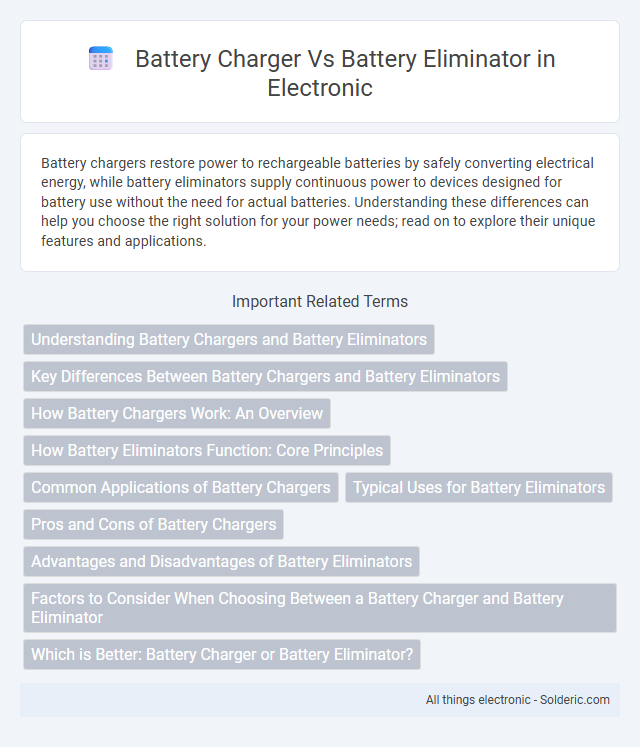Battery chargers restore power to rechargeable batteries by safely converting electrical energy, while battery eliminators supply continuous power to devices designed for battery use without the need for actual batteries. Understanding these differences can help you choose the right solution for your power needs; read on to explore their unique features and applications.
Comparison Table
| Feature | Battery Charger | Battery Eliminator |
|---|---|---|
| Purpose | Recharges rechargeable batteries | Replaces batteries by providing direct power |
| Power Source | AC or DC power to recharge batteries | Direct AC/DC power supply, no battery needed |
| Usage | Restores battery capacity for reuse | Provides continuous power, ideal for stationary devices |
| Application | Rechargeable battery packs, AA, AAA, Li-ion, NiMH | Electronic devices, test equipment, toys, wireless systems |
| Battery Dependency | Requires batteries for operation | No battery required |
| Cost Efficiency | Cost-effective for multiple recharges over time | Cost-effective by eliminating battery replacements |
| Environmental Impact | Reduces battery waste by reusing batteries | Eliminates battery waste completely |
Understanding Battery Chargers and Battery Eliminators
Battery chargers restore energy to rechargeable batteries by converting electrical power into a controlled charging current, ensuring optimal battery performance and lifespan. Battery eliminators, on the other hand, provide continuous power directly from an external source, effectively replacing the battery in devices that require stable, uninterrupted voltage. Understanding the difference helps you choose the right solution for powering or recharging your electronic devices efficiently.
Key Differences Between Battery Chargers and Battery Eliminators
Battery chargers convert AC power into DC power to recharge batteries by restoring their energy through controlled current flow, whereas battery eliminators provide a continuous DC power supply to replace batteries entirely without the need for recharging. Key differences include functionality--chargers restore battery capacity, while eliminators bypass the battery by supplying regulated DC voltage directly to the device. Chargers often feature safety mechanisms like overcharge protection, whereas battery eliminators focus on stable voltage output to ensure device operation without battery dependency.
How Battery Chargers Work: An Overview
Battery chargers convert electrical energy from a power source into chemical energy stored in a battery by applying a controlled current and voltage. They monitor the battery's voltage to regulate the charging process, preventing overcharging and ensuring optimal battery health. Unlike battery eliminators, which supply direct power without recharging, battery chargers rejuvenate battery capacity for portable devices.
How Battery Eliminators Function: Core Principles
Battery eliminators function by supplying a constant DC voltage that mimics the output of a battery, effectively replacing the need for physical batteries in electronic devices. They regulate voltage and current to ensure stable power delivery, preventing fluctuations that could damage your equipment. This core principle allows devices to operate continuously without the interruptions caused by battery depletion or replacement.
Common Applications of Battery Chargers
Battery chargers are commonly used to recharge portable devices like smartphones, laptops, electric vehicles, and power tools by replenishing their battery capacity for extended use. Unlike battery eliminators, which provide direct power to devices without storing energy, battery chargers are essential in applications where mobility and battery longevity are crucial. Your choice of a battery charger depends on the device's voltage, current requirements, and battery chemistry to ensure safe and efficient charging.
Typical Uses for Battery Eliminators
Battery eliminators are commonly used in applications where continuous power supply is essential, such as in audio equipment, radio transmitters, and industrial machinery, eliminating the need for batteries. These devices replace batteries by providing a stable DC voltage from an AC source, ensuring uninterrupted operation and reducing maintenance. Unlike battery chargers, battery eliminators are not designed to recharge batteries but to act as a direct power source in battery-dependent equipment.
Pros and Cons of Battery Chargers
Battery chargers restore rechargeable batteries by supplying controlled electrical energy, enhancing device longevity and reducing waste; however, they require time to recharge and may degrade battery capacity if overused. They support various battery chemistries like Li-ion, NiMH, and lead-acid, offering versatility but demand compatible settings to avoid damage. Despite these advantages, chargers consume power and can present safety risks if defective or improperly handled.
Advantages and Disadvantages of Battery Eliminators
Battery eliminators provide a continuous power supply without the need for recharging, eliminating downtime associated with battery replacement and reducing long-term costs. However, they limit portability since the device must remain connected to an external power source, and voltage incompatibility risks can damage sensitive electronics. Your choice depends on whether convenience and uninterrupted operation outweigh the flexibility of battery-powered use.
Factors to Consider When Choosing Between a Battery Charger and Battery Eliminator
When choosing between a battery charger and a battery eliminator, consider the power source requirements and device compatibility, as chargers replenish battery energy while eliminators substitute batteries by converting AC to DC power. Evaluate the application environment, as chargers are ideal for portable use with rechargeable batteries, whereas eliminators provide continuous power in fixed locations, eliminating battery replacement. Assess energy efficiency, safety features, and device voltage specifications to ensure optimal performance and longevity.
Which is Better: Battery Charger or Battery Eliminator?
A battery charger replenishes the energy in rechargeable batteries, extending device usability and supporting portable power needs, whereas a battery eliminator substitutes batteries by directly converting AC power to DC, providing continuous operation without the need for battery replacement. Battery chargers are better for maintaining battery health and ensuring mobility, while battery eliminators are ideal for stationary devices where uninterrupted power is critical. Choosing between them depends on device portability, power requirements, and convenience preferences.
battery charger vs battery eliminator Infographic

 solderic.com
solderic.com